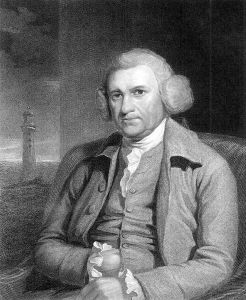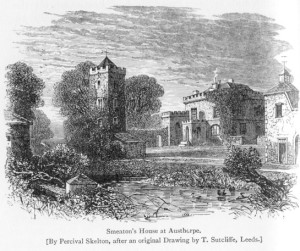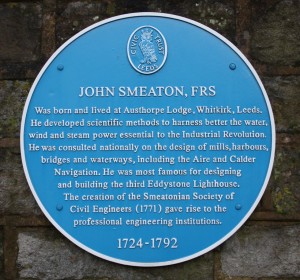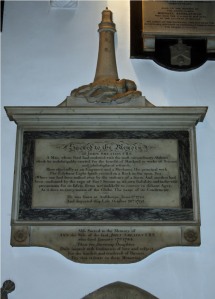In James Ferguson’s celebrated book, Astronomy Explained Upon Sir Isaac Newton’s Principles (1778), there is a table for the Equation of Time. It gives figures for how much a clock should be faster or slower than the Sun at different times of the year. Ferguson says that the table is ‘by Mr Smeaton’.
This is John Smeaton (1724-92), who is justly famed for the design and construction of the third Eddystone Lighthouse. Many of his great engineering works – mills, harbours, bridges and waterways – are still in use today. Smeaton was the archetypal civil engineer, as opposed to the previous mainly military engineers.
So, how did it come to pass that an arcane astronomical table should be provided by a civil engineer?
Although Smeaton’s later professional life was dominated by the civil engineering works for which he is still honoured, his election to the Royal Society at the age of 28 preceded any of these works and was the result of his earlier role as a maker of ‘philosophical instruments’. Throughout his life his ‘leisure’ hours were dominated by an intense interest in astronomical matters. Indeed, such matters were the only things allowed to occasionally impinge upon his engineering work. His daughter, Mary, recounted that “his time was governed by a method as invariable as inviolable: for professional studies were never broken in upon by any one; and these (with the exception of stated astronomical observations) wholly ingrossed the forenoon”.
John Smeaton was born at Austhorpe Lodge, in Whitkirk, East Leeds, on 8th June 1724 and lived there for much of his life. Unfortunately, the Lodge was demolished in the 1930s. Here we would have seen the the tower that he built, on top of which he made his astronomical observations. One floor lower was the design office for his professional work and at the base of the tower was the workshop, where many of his experiments were conducted and his instruments were fabricated.
Smeaton’s father had a legal practice in Leeds, but from an early age John seemed to drawn more to the profession of his grandfather, who had been a watchmaker of some renown in York. Already, by the time he left Leeds Grammar School at the age of 16 he had his own workshop. A distant cousin, visiting John two years later, reported that “in the year 1742, I spent a month at his father’s house, and being intended myself for mechanical employment, a few years younger than he was, I could not but view his works with astonishment; he forged his iron and steel, and melted his metal; he had tools of every sort … He had made a Lathe, by which he cut a perpetual screw in brass, a thing little known at that day, and which I believe was the invention of Mr Henry Hindley, of York …. Mr Hindley was a man of the most communicative disposition, a great lover of Mechanics, and of the most fertile genius. Mr Smeaton soon be-came acquainted with him, and they spent many a night at Mr Hindley’s house till day light, conversing on those subjects.”
The prominence given to the perpetual screw, mentioned in this account, perhaps owes something to Smeaton’s own estimation of its importance. This screw was essentially a precision worm gear for the careful adjustment of setting circles and arcs on astronomical instruments so as to achieve accurate measurements. The screw had an ‘hour-glass’ – rather than cylindrical – shape, which was calculated to reduce any play (or ‘drunkenness’) in the gearing. Its manufacture required a sophisticated dividing engine and Smeaton rightly saw such devices as being crucial for the advancement of astronomy.
Not long after his first acquaintance with Hindley, the young Smeaton was sent to London to commence a legal educa-tion – perhaps by parents who were becoming alarmed at their son’s bent for mechanical matters rather than more gentlemanly occupations. Within two years he returned, persuaded that legal circles were not for him. Whilst in London, however, he had met and formed crucial friendships with Benjamin Wilson and other Royal Society members and he continued a correspondence with them which frequently dealt with astronomy. Soon he resolved to make a profession out of building scientific instruments. This was to be a lifelong passion. By the age of 23 he had built his own telescope and had become, in his own estimation ‘quite an artist’ at grinding and polishing lenses.
In 1748, aged 26, with parental blessing, he departed once more for London to start his instrument building career. The first product of this endeavour was a vacuum pump that ended up being used (by Wilson and others) in electrical discharge experiments.
One of the next fruits of his industry was a marine compass (developed in collaboration with Dr Knight). Smeaton submitted a paper on this to the Royal Society in July 1750. Other high quality instruments followed – including a telescope for John Ellicott and a precision lathe for William Matthews. Around this time he also began his pioneering experiments on the power of water and wind. All in all, it was clear that, as well as being a formidable instrument builder, Smeaton was a first class scientist. In December 1752, he was proposed by Lord Charles Cavendish for membership of the Royal Society and in March 1753, with the support of James Short, William Watson, and others, he was duly elected.
Smeaton’s career now turned decisively to engineering. He put his hand to the design of water-mills, masonry bridges and drainage schemes. His scientific approach to these commissions – at once both analytical and experimental – made its mark with other fellows of the Royal Society. So much so, that when the lighthouse on the Eddystone Rock was destroyed by a storm in 1755, the President of the Royal Society (Lord Macclesfield) advised the owners that Smeaton – an engineer with no previous experience of lighthouse construction – was the ideal man to take charge of the design and building of a new one!
By October 1759 the new lighthouse – the third on the Eddystone Rock – was permanently operating and ultimately it became the archetypal symbol of civil engineering in Britain, featuring on the crest of the Institution of Civil Engineers. It also forms the centrepiece of the Smeaton memorial at Whitkirk Parish Church (see photograph).
Around 1760 Smeaton, his wife Ann, and their baby daughter moved back to Austhorpe Lodge in Leeds and set about its renovation.
The demand for Smeaton’s engineering skills continued to escalate and inevitably took up most of his time, but astronomical interests were not neglected.
In the May of 1768 two papers of Smeaton on astronomical topics were read to meetings of the Royal Society: The first concerned the gravitational influence of the Moon upon the Earth and its effect on apparent planetary positions at different stages of the lunar month; The second was on a method of accurately determining the position of a celestial body, using a transit telescope, even though the body was far away from the meridian.
On 4th June 1769, the day after he missed seeing the transit of Venus, due to clouds, Smeaton made careful measurements of a partial solar eclipse (magnitude 0.576) from his Austhorpe observatory, using a Dollond refractor and a micrometer.
Although he personally didn’t witness the Venus transit, Smeaton still managed to contribute to the international observing effort, for it was he who had designed the portable observatories for the purpose taken to Tahiti by Captain Cook and to Hudson’s Bay by William Wales and Joseph Dymond. Smeaton also designed fixed astronomical observatories for several sites in the UK: including Thorley Hall (Matthew Raper) and Deptford (Alexander Aubert). The current observatory in the Yorkshire Museum Gardens in York too is reputed to have been designed by him.
From Austhorpe, John Smeaton maintained regular correspondence with his scientific friends, including the Reverend John Michell of Thornhill, about twenty kilometres away, whom he sometimes visited. Michell is credited with first envisioning the existence of ‘black holes’ and with devising the experimental apparatus which allowed Cavendish to ‘weigh’ the Earth. Michell was also an ambitious telescope constructor and in this he received much encouragement from Smeaton, who visited his workshop and on occasion stayed at his house.
In the late 1780s Smeaton submitted further papers to the Royal Society on astronomical matters, the first being a masterly survey of the history of the graduation of scales on observing instruments. This formed the introduction to a detailed description of the method invented by his deceased friend, Henry Hindley.
The next paper concerned observations of Mercury at greatest elongation that Smeaton had made in the autumn of 1786, using an equatorial micrometer of his own design and construction. This was followed by a report describing a patented improvement (a ‘quadrant of altitude’) that he had devised for the celestial globe and how it could be used to solve problems of positional astronomy.
John Smeaton died on 28 October 1792, six weeks after having a stroke as he walked through his beloved garden at Austhorpe. according to his daughter, “He always apprehended the stroke, as it was hereditary in his family; he dreaded it only as it gave the melancholy possibility of out-living his faculties, or the power of doing good: to use his own words, ‘lingering over the dregs, after the spirit had evaporated!'”. Thankfully, however, his memory and intellect during his final weeks seemed to have been spared. “He would sometimes complain of his own slowness (as he called it) of apprehension, and then would excuse it with a smile, saying, ‘It could not be otherwise, the shadow must lengthen , as the sun went down!’ There was no slowness in fact to lament; for he was as ready at calculations, and as perspicuous in explanation, as at any former period….. The body gradually sunk, but the mind shone to the last.'”




